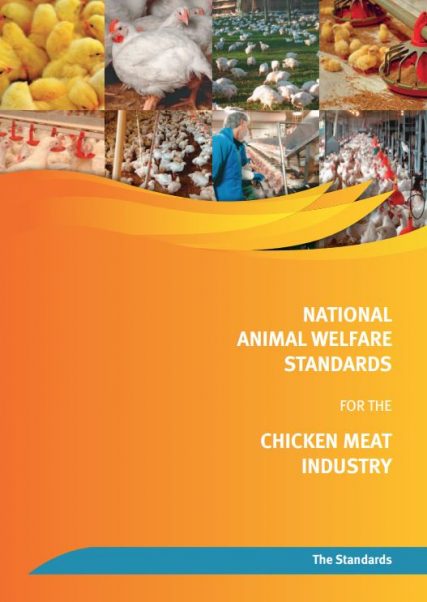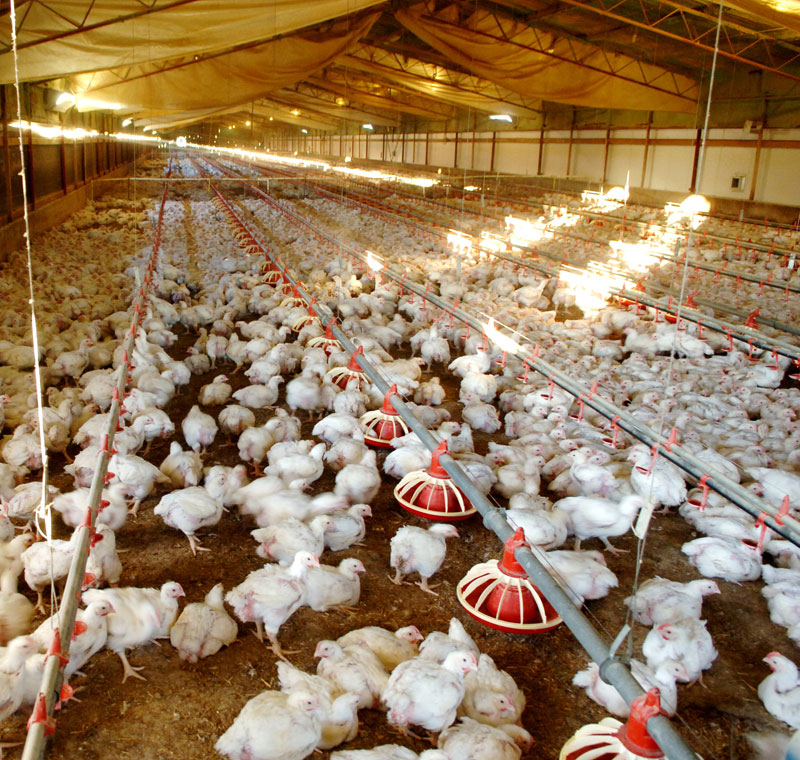Welfare standards for the chicken meat industry

Welfare standards for the chicken meat industry
National animal welfare standards for the chicken meat industry published by Australian Poultry CRC (2008) were developed to help fulfil both industry’s and the community’s expectations of high levels of quality assurance associated with chicken meat production. The documents provide welfare standards for all sectors of the commercial chicken meat industry, from egg laying to slaughter. These standards are based on the 2001 document ‘Welfare Audit for the Chicken Meat Industry’ that has both been restructured and revised to ensure the information is both current and relevant. In the previous years there have been both structural and practice changes.
There has been some consolidation into fewer but larger farms. Whereas the average bird capacity of growers’ farms in 2000 was just over 89,000 birds (VFF members’ farms in Victoria), an average farm size in 2007 of around 200,000 birds was not uncommon. Simultaneously, the number of birds processed has increased from around 415 million in 2001/02 to over 628 million birds in 2015/16 and chicken meat consumption has increased from less than 32.0 to 46.2 kg/person in 2016, with an estimated increase to 49.0 kg/person in 2020. Practice change has involved the use of improved equipment in new sheds as it becomes available. Improvements include monitoring equipment for drinker lines and humidity, more automated recording (eg. temperature, humidity, etc.), more even ventilation through use of improved equipment and stirring fans and some installation of concrete flooring. Practice change has also involved the use and application of new knowledge and equipment including, breeding of birds with fewer leg problems, better matching of different feed and environmental requirements of different breeds of bird, re-use of litter, more use of mechanical bird harvesters at pick-up and the use of infra-red beak trimming equipment.
Broiler industry mission statement on bird welfare
The conditions under which broilers are housed and the way that they are managed during their growing phase, transportation and slaughter are set down in several government/industry endorsed Model Codes of Practice designed to safeguard their welfare.
Welfare audit program
The industry has developed a model welfare audit program, which covers hatchery, breeder rearing, breeder laying, growing, and the pick-up, transport and processing sectors. Several companies have incorporated elements of this welfare audit in their own quality plans. All companies incorporate elements of good practice for bird welfare in their grower manuals.
Economic performance and welfare
High standards of bird welfare and high levels of flock performance and economic performance are not incompatible – quite the contrary, they go hand in hand. It simply makes good economic sense as well as being in the bird’s best interests to ensure that flocks are maintained in an environment in which they are thermally comfortable, protected from injury, fed optimally and kept healthy. Therefore, all measures described elsewhere to ensure that chickens are kept in conditions which optimise their comfort (in terms of temperature, humidity, air flow and air quality), in which they are provided with water, shelter, and a high quality diet that exactly matches their physiological needs, and which optimise their health have just as important effect in terms of bird welfare as they do on the overall efficiency of the farming operation.

Broiler shed interior
Economic performance and welfare
High standards of bird welfare and high levels of flock performance and economic performance are not incompatible – quite the contrary, they go hand in hand. It simply makes good economic sense as well as being in the bird’s best interests to ensure that flocks are maintained in an environment in which they are thermally comfortable, protected from injury, fed optimally and kept healthy. Therefore, all measures described elsewhere to ensure that chickens are kept in conditions which optimise their comfort (in terms of temperature, humidity, air flow and air quality), in which they are provided with water, shelter, and a high quality diet that exactly matches their physiological needs, and which optimise their health have just as important effect in terms of bird welfare as they do on the overall efficiency of the farming operation.
Bird health and welfare
When producing chicken meat in a welfare-friendly manner it is also important that the birds receive prompt and appropriate medication and treatment to prevent and treat diseases if this should become necessary, and that they do not suffer any unnecessary pain, distress, fear or physical injury. It is also important that sick or injured birds that can not be adequately or successfully treated are culled quickly and in a humane manner so that they do not suffer.
Humane slaughter
While the chickens are reared specifically for human consumption and they therefore at some stage have to be slaughtered, the industry is mindful that they should be slaughtered in a humane manner. To this end, all birds are stunned (rendered insensible to pain) prior to slaughter.
Industry has three strong motives for looking after the birds in their care in a welfare-friendly manner:
- Out of respect for the birds themselves, so they do not suffer.
- So that they grow as well and efficiently as possible and they are not damaged in the process.
- In recognition of, and respect for, the consumer, retailer and community attitudes and expectations with respect to the humane treatment of livestock farmed specifically for their consumption.
References
National Animal Welfare Standards for the Chicken Meat Industry, Manual for Meat Chicken Farming. Prepared by: Barnett, J.L., Edge, M.E., Thomson, L., Mackenzie, M., Sansom, G. Kite, V., Australian Poultry CRC Pty Ltd 2008.
Model Code of Practice for the Welfare of Animals – Domestic Poultry 4th Edition (2001). CSIRO Publications, Australia.

